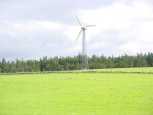|
WINDS OF CHANGE Geoff Leet Historically Caithness had a sufficient water power for grinding corn and snuff, and for pounding flax, so only used windmills to pump slate quarries. Our only serious windmill is modern. The windmill at Langwell was kindly shown to the Society of Northern Architects (and one spouse, myself) by Richard Howden, the Estate Factor. The November afternoon was mild and the east wind was gentle. The tips of the great three-bladed propeller flew at 92 miles per hour but were almost silent, just a "whisk-whisk-whisk" could be heard, and I felt a silent quiver when I touched the steel tower. COMPARATIVE POWER GENERATION The 75 kW windmill was built over 5 years ago by Vestas in Denmark who produce about 10 a week, and whose experience extends pre-war. The present Vestas range goes up to 500 kW machines. The great Orkney windmill is 3 MW, but is experimental and not always working. A modern conventional power station would produce 1200 MW. THE ENGINEERING The Langwell windmill has blades of fixed pitch which always rotate at 45 revolutions per minute to drive a gearbox which turns the 75 kW alternator at 1000 rev/min feeding the Hydro Electric Grid. A second 23 kW motor/alternator is used to spin up the blades when the wind is light and also to generate when the big alternator would be uneconomic. A weathercock detects the wind direction and the windmill is automatically motored round to face the new direction. Spinning cups measure the wind speed, so when the velocity increases from zero to a few miles per hour, the cups signal the need to spin up the blades. When the wind speed exceeds 63 miles per hour, the blades will be stopped by a brake and the whole windmill turned at right angles to the wind to ride out the storm. If the controls and the brakes fail, the blades will speed up to 55 rev/min, when the tips will extend and turn automatically to act as air brakes, preventing speed increase. The power cable from the windmill head dangles in a loop and can accept 3.5 turns. If the wind persists in turning the windmill in the same direction, the brake will be automatically applied, the windmill will unwind itself, and restart. The use of fixed pitch blades on a constant speed machine simplifies and cheapens the hub, but requires an airfoil able to accept airflow from a large range of angles, a compromise which reduces blade efficiency. Later Vestas windmills use variable pitch blades. THE ECONOMICS Suitable wind is available for some generation for 75% of the of the time, so annually only about 40% of the full installed power will be delivered to the grid. If erected in Yorkshire, the windmill would be paid 8p per kWh. In Scotland, only 2p was paid until 1992 when the rate rises to 5.2p. The Langwell windmill was rated for local taxes at �3200 a year, which negotiations reduced to �300. Annual visits from the makers cost �300. Langwell might expect to earn 75 kW x �0.052 x 40% x 24 hours x 365 days = �13,665 to pay expenses, interest and repay capital over say, 20 years. FUTURE DEVELOPMENTS One of the Dounreay measuring masts was erected at Ousdale a few months ago to investigate a costal site, and Langwell Factor Richard Howden hopes to make a case to erect three 500 MW Vestas windmills there, feeding the adjacent power lines. Windmill power will always be intermittent, so behind every windmill must be some other power station ready to take up the load. This limits the value of the power source but wind can be accepted up to 10% of the total grid supply: a large market, not yet tapped. In Scotland the bottleneck is the feeble grid to England (which also buys power from France). |
